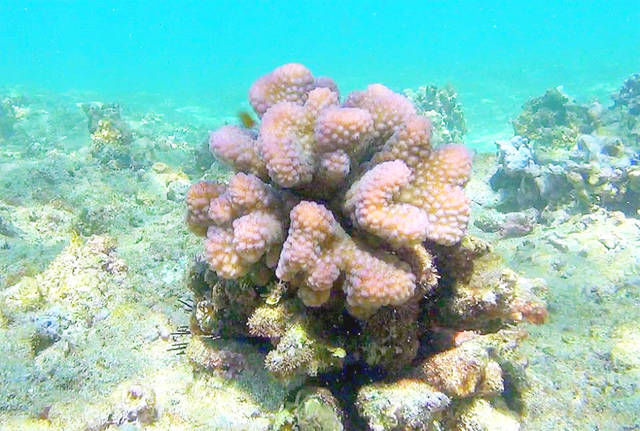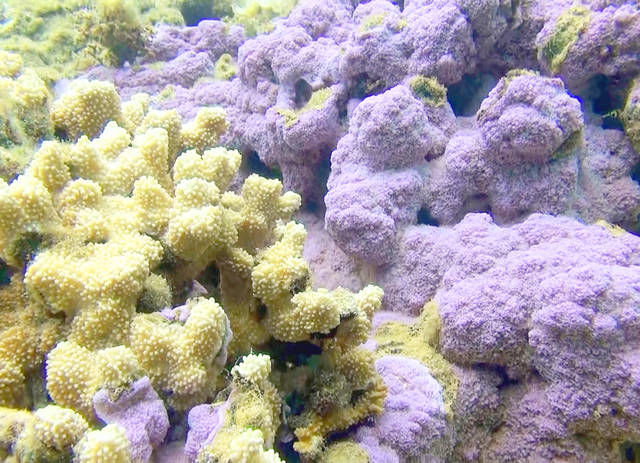This is the third in a series on the factors relating to the health of coral reefs globally and around Kauai. Watch upcoming issues of The Garden Island for articles investigating the connection between watersheds and reefs, things affecting reef
This is the third in a series on the factors relating to the health of coral reefs globally and around Kauai. Watch upcoming issues of The Garden Island for articles investigating the connection between watersheds and reefs, things affecting reef health, and ways individuals can help save the reefs.
LIHUE — There’s a web of secret passageways used by pollutants to reach the reefs that fringe Kauai’s beaches.
While streams are convenient paths for excess nutrients, pharmaceuticals, personal care products and pesticides, they find their way down the mountain using underground methods as well.
“We are putting these things into the ocean and onto the reef; and while many are focused on the streams because they’re kind of an obvious point source, another pathway is groundwater outflow,” said Henrietta Dulai, a geochemist and associate professor at the University of Hawaii who studies submarine groundwater discharge.
SGD is the secret passageway — that freshwater you feel when you shuffle your feet along the bottom of a warm bay.
It’s fresh water that’s leaking from the aquifers into the ocean. It is a natural part of the water cycle, Dulai said, and the reefs get necessary nutrients from the submarine groundwater discharge.
But, researchers are showing that the concentration of nutrients in SGD around the island has increased, and it’s brought company.
“Let’s use the very simple example of nitrogen,” Dulai said. “It’s a nutrient, meaning it’s a food in for the reef.”
Nitrogen seeps naturally into the groundwater from organic matter and directly from the soil, but when groundwater flows below urban areas on its way to the ocean, it passes by cesspools and septic systems.
“Suddenly you see a huge increase in nitrogen concentration in the groundwater and then the water that discharges into the ocean carries this signature with it,” Dulai said.
Scientists have identified the isotopic signature of the nitrates that come from cesspools, and can separate them from the nitrogen from other sources.
When all that nitrogen seeps onto the reef, it feeds invasive algae, which throws off the balance of the reef, but it also increases overall photosynthesis, or the process the algae in the reefs use to eat.
This is where ocean acidification comes into play and how it can affect the reefs.
The photosynthesis process takes up dissolved inorganic carbon that would otherwise lower the pH in the water.
At night, plants engage in an opposite process called respiration, which breaks down the organic matter and dissolve it into inorganic carbon.
“In places where you have pollution of nitrogen and phosphorous you see higher swings between (potential hydrogen) levels day and night, and that is something that the reef might not prefer,” Dulai said.
While streams are a point source and can potentially transport larger amounts of pollutants into the ocean. Streams aren’t always full; some tend to run only during certain times of the year.
Submarine groundwater discharge, however is a 24-7 gig.
“It’s not as evident (as stream flow) and groundwater might have lower values, but it’s chronic,” said Curt Storlazzi, research geologist with the U.S. Geological Survey Pacific Coastal and Marine Science Center.
He continued: “We’ve got cars leaking oil, leach fields going into the groundwater.”
Lava tubes and other pathways take the water from mauka to makai and usually there’s a diffused flow from the aquifers that surrounds the periphery of the island.
In some cases, like when you find that cold spot of water in a bay, it comes out from the ground in a more focused stream, diffusing pollutants into the ocean along with the fresh water.
In 2003, Dulai did a comparison of Hawaiian near-shore ocean pH levels and open-ocean pH levels, using data from the Hawaii Department of Health and from the University of Hawaii’s offshore monitoring station, Station Aloha.
They found that the Kauai locations they tested had ocean acidification happening twice as fast as that at Station Aloha, which has been measuring increased CO2 concentration in the atmosphere in the open ocean.
Then, in 2007, Dulai teamed up with the local Surfrider chapter and Carl Berg (head of the Kauai Surfrider Blue Water Task Force) in 2007 to do a water quality study on Kauai’s South Shore.
Dulai and Berg found data that points to pesticides in groundwater as well as other pollutants.
“We have shown that groundwater has just as much pesticides dissolved in it as surface water,” Dulai said. “So this groundwater discharge might be an important pathway for some of the pesticide into the ocean. “
Oil from cars, lawn care and cleaning products, insecticides and pesticides from home use, and things like caffeine and anti-seizure medication can leak into the groundwater from sources as it makes its way to the ocean.
The question of what’s harming the reefs and causing their worldwide decline is complex and has different parts in play, Storlazzi said, but he and other experts say SGD is one piece of that puzzle.
“The reef appears to have chronic stressors and a lot of it is being caused by human induced factors,” said Storlazzi. “Anything leaking from the yard or from the street is going into the groundwater.”



